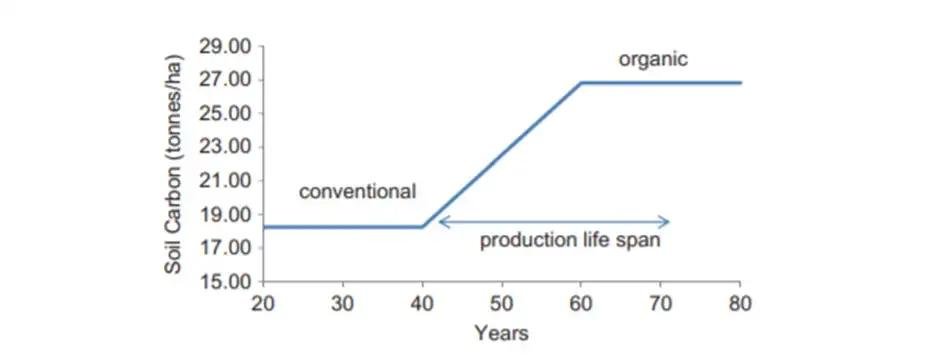· 9 min read
Soil carbon sequestration is central to the recent IPCC special report on climate change and land. The OECD estimates that net soil carbon sequestration could offset 4% of average annual global greenhouse gas (GHG) emissions over the rest of the century. The organic industry is attempting to lead the way in carbon sequestration through regenerative farming methods. National environmental organizations such as NRDC are advocating for regenerative agriculture. Major food companies are committing to it as part of their climate strategies. New certifications are emerging to help define and codify the term “regenerative”.
And yet, for all the buzz around regenerative farming in climate circles, a look at the science under the surface reveals a number of serious problems that would have to be solved before it is ready to take on the climate challenge at scale.
Regenerative or organic?
Let us start with some terminology and definitions to help the rest of the discussion. The explicit goal of regenerative agriculture is to reverse climate change by rebuilding soil organic matter which can sequester carbon in the soil. There are other potential benefits such as restoring soil biodiversity and improving the water cycle. The practice of regenerative farming looks very much like organic farming as far as conservation tillage, cover cropping, crop rotations and the use of amendments like compost and manure.
Both organic and regenerative systems use nitrogen-fixing cover crops and legumes in crop rotations to supply much of the nitrogen required by the next crops. The cover crops, along with compost and manure, do double duty by helping to build soil organic carbon pools while also serving as the principal nitrogen sources.
While buying “organically” produced food can assure you that the land on which it was grown was managed without the use of most synthetic fertilizers and pesticides, “regenerative” focuses on the state of the soil as an outcome of the same or similar agricultural practices. Certifications like Regenerative Organic Certified make this connection explicit. “Organic” is the established term in much of the research literature, and we will use “organic” and “regenerative” interchangeably in this article.
Why are organic yields consistently lower than conventional?
Multiple studies over the years have shown that organics have consistently lower yields than conventionally grown crops. A meta-analysis in 2012 found that organically grown grains and vegetables have a significantly lower yield (26–33% lower) than conventionally grown crops, but fruits and oil seeds show a much smaller difference (3–11%).
One reason for this is that organics in general are nitrogen-limited because the release of plant-available mineral nitrogen from cover crops, compost or animal manure is slow and often does not keep pace with the high nitrogen demand during the peak growth period. Perennials perform better than annuals because their extensive root systems and longer growth periods allow them to align growth with nitrogen availability much better than annuals. Legumes perform better than non-legumes because of their ability to fix nitrogen through their root systems.
Looking at farming systems across multiple crops, a second limitation becomes clearer. As much as 85% of the nitrogenin organic farming systems comes from cover crops or leguminous food crops (the other 15% may come from inputs like compost and manure). When legumes are grown as cover crops (to be plowed under later) explicitly for the purpose of adding nitrogen to the system, the average yield of food crops over the entire rotation is reduced because the land is not producing food crops for some period of time. This is a farming system-level effect that is not captured in crop-level yield comparisons of organics and conventionals, but must be included in the larger impacts of switching to organic/regenerative farming at scale.
A 2019 study did exactly this when examining the effects of hypothetically converting all food production in England and Wales to organic methods, and found that this switch would increase net GHG emissions even after accounting for soil carbon sequestration because the lower organic yields would trigger additional food imports which in turn would require more land to be cleared for agriculture in other parts of the world.
GHG emission comparisons of organic and conventional crops using life-cycle assessment (LCA) typically account for the crop-level yield loss due to nitrogen limitations, but not the system-level yield losses due to fertility-building cover crops or leys. This system boundary issue in the modeling can make organics look better in LCA comparisons than they really are.
The missing nitrous oxide (N2O) emissions
LCA studies of organic and conventional crop production will generally include the N2O emissions generated by the soil denitrification process as part of the nitrogen cycle. But the system boundary limitation mentioned above comes into play again, keeping the nitrogen added to the soil by previous crops in the rotation outside the scope of a given crop-level LCA. This means that LCAs have been routinely underestimating the total GHG emissions per unit of organic production in two ways that are related: by not considering the loss of system-level yield due to the need to grow cover crops, and by excluding the additional N2O emissions triggered by the nitrogen added by those cover crops and previous leguminous food crops.
Even with these underestimated emissions, LCA studies do not show that long-term organic crops have a clear climate advantage over conventional crops. Once we factor in the system-level effects across multiple crops in a rotation, organics at scale will look even worse from a climate perspective. The one saving grace could be carbon sequestration in agricultural soils, but that brings with it a new set of issues.
The limits of soil carbon sequestration
Land management practices such as reduced or no till — combined with the addition of organic inputs to the soil in the form of crop residues, compost, or manure — can in principle add to or preserve the soil organic carbon in soils. But soil is not an infinite carbon sink. Under the right management practices and conditions, soil organic carbon content will increase up to a point (depending on the soil type, climate zone, tillage practices, etc.) and then reach equilibrium as illustrated below. Under the IPCC tier 1 model used in most LCAs, the default time period for stock changes is nominally 20 years and management practice is generally assumed to influence stocks to a depth of 30 cm.

There is, however, wide variability and crop specificity in field measurements of soil carbon stocks and evidence that the soil carbon on cropland producing annual crops may have been systematically overestimated in LCAs, thus overstating the benefits of soil carbon sequestration in many of the common organic crop production systems.
Two other concerns revolve around the fact that reduced or no till plays a key role in the carbon sequestration. Much of the increase in soil organic carbon from no-till appears to be a redistribution of the carbon rather than a net increase. A meta-analysis comparing 69 sets of paired data for no-till and conventional till, with sampling down to a 40 cm depth, showed no overall increase in soil carbon stocks under no-till: larger carbon stocks in the top 20 cm were balanced by smaller quantities in the next 20 cm layer.
Moreover, any carbon that is actually added to the soil under reduced/no-till is mainly in labile forms that would be lost through decomposition of soil organic matter if a farmer discontinued the no-till management and went back to conventional tillage. The permanence risk of this carbon capture method is very significant.
Will manure turn into a scarce resource?
Animal manure has been the traditional go-to source to supplement the nitrogen produced on-farm using nitrogen-fixing cover crops and legumes. Historically animals were confined at night to deposit manure in specific areas being prepared for the next cropping cycle. This practice continues to this day in small, integrated farming systems. As stated earlier, about 15% of the nitrogen required by organic crops is generally supplied by soil amendments like compost and manure. Because organic crops are often nitrogen-limited, these amendments would need to be high in nitrogen content (at least 2% nitrogen by dry weight in order to replace synthetic fertilizers) which generally requires manure composts with a C/N ratio not exceeding 10.
Organic crops targeting high yields will require large supplies of manure, mostly from intensive animal farming. This dependence is problematic considering that animal farming is responsible for 64% of agricultural emissions and our diets would need to be much more plant-based in the future for climate reasons alone. In addition, the crops that are used as animal feed to produce manure need land, water and other resources and will generate their own GHG emissions.
If organic farming expands rapidly, there may well come a point where the supply of manure becomes a limiting factor. Manure is a bulky and difficult-to-handle substance that is suited for use close to where it is produced. It is generally the case that manure would not be transported over long distances from livestock dominated regions to arable regions due to transport costs, increased disease transmission risk and odor. If it were somehow feasible to transport it, the large GHG emissions from transport alone would make the resulting organic crop significantly worse than comparable conventional crops. The production and transport constraints of manure could limit the growth of organic farming in the future.
Can regenerative agriculture go from hype to solution?
For organic/regenerative farming to be a viable climate solution, yields need to be shored up across the board while keeping soil-related emissions to a minimum. Cover cropping and crop rotations play a key role in supplying much of the nitrogen needed by the next crops while also helping to build up soil carbon stocks. However, it is clear from the data that organic crops are often nitrogen limited and the mineralization rates of organic nitrogen do not keep up with the demand in the peak growth phase.
One possible solution might be to use synthetic nitrogen as a supplement in the growth period to match the demand. This would allow for more precise control of plant-available nitrogen, increasing it above a baseline when needed and then dialing it down when it is not needed in order to reduce costs as well as N2O emissions from the soil. Synthetic nitrogen as a supplement could also alleviate any future constraints in the supply and availability of manure. Crop systems using this approach would of course no longer qualify as “organic”, but they could very well be “regenerative” because of the continuing use of cover crops, crop rotations and the use of available organic amendments to build healthy carbon-rich soils.
There is, of course, more to this than just the science. For regenerative farming to scale up as a major climate solution, many of the hundreds of millions of small farmers in the world would need to change the way they farm in the next few decades. This would be a social and economic change at an unprecedented scale and pace for agriculture and would only be feasible if farmers are confident that there would be no yield losses compared to conventional farming methods.
Feeding the world in 2050 and beyond will require producing more from the same agricultural lands while definitively tackling climate change. Regenerative farming still has a way to go before it can truly be part of the solution.
This article is also published on the author's blog. illuminem Voices is a democratic space presenting the thoughts and opinions of leading Sustainability & Energy writers, their opinions do not necessarily represent those of illuminem.






